Abstract
The report shows meaningful comparison between HSBC and Saudi Hollandi Bank. HSBC head quarter is located in London and Saudi Hollandi Bank in Saudi Arabia. The key activities are same for both bank but the ways of working is different as Saudi Hollandi Bank is guided with Islamic rules. HSBC is more diversified with greater degree of assets and consumer market segmented. The key profitability for HSBC is better but Saudi Hollandi Bank also in a good position. Strategic management is followed by HSBC greatly as it is more diversified. For marinating soundness of balance sheet both of the banks are engaged in off balance sheet management.
Introduction
From investors perspective analyzing of banking structure is must. Potential return with investments with minimizing risks procedure can be comprehended if anyone can analyze these issues. So, to understand banking financial system several key points should be taken into consideration and the report is designated for this purpose.
Methodology
To evaluating the comparison several topics has chosen such as the operating structure of the financial institution, board powers, management structure, Bank risk management processes and internal controls. Regulatory supervision and reporting, Market penetration, segmentation, strategy, product mix, Asset, liability management PL trends has also analyzed. Competitive analysis, technology usage/branching-domestic and international, strategic alliances, Loan/loss provisions and policies, Asset/liability diversification, Derivative product risk management, and Off balance sheet management are relevant. The differences and relationship has been evaluated between two banks.
Theoretical aspects
To illustrate the comparison, various terminologies are used. These are clarified here. Bank’s risk management process has determined by credit risks, liquidity risk, business risk and market risk. These risks change the pattern of the transaction. Marketing process is conducted here. Brigham, E. F., & Houseton, J. F. (2004,pp. 244-294) and Pandey, I. M. (2007, pp 136-187) defined that, segmentation is a process by which a market dividing into distinct groups of buyers with different needs. Characteristics, or behavior who might require separate products or marketing mix and the process of evaluating each marketing segments attractive and selecting one or more segments to enter. Market positioning is the process of formulating competitive positioning for a product and a detailed marketing mix. Marketing mix are product, price, place, promotion. Off balance sheet items are used to show the firms income generating activities which may not include in the balance sheet. According to Mishkin, F. S. (2000, pp. 33) ‘Off balance sheet involves trading financial instruments and generating income fees and loan sales activities that affect banks profit but do not appear on bank balance sheet.’ Competitive analysis has been conducted with the comparison among the two. The competitive analysis will verify the HSBC sustainability and future prospect. The asset liability model expresses the gap between assets and liabilities. The gap is estimated to get a picture of firm’s ability to meet its current obligations. Diversification of asset and liabilities shows the distribution in different regions or in terms of classification.
Operating structure of the Banks, board powers, management structure
Operating structure
HSBC
HSBC headquartered in London, has 17 directors, 3 executive directors, 14 non-executive directors, 12 no-executive directors are independent. The board is responsible for managing stakeholder’s interest and guidance of their asset. All directors are to be elected by stakeholders in AGM. The management board cannot implement policy without stakeholders and executives consent. HSBC board committees are: Group management board, Groups audit committee, Remuneration committee, Nomination committee and CSR committee. HSBC comprises 10000 offices in 83 countries and territories. The geographic area is segmented as below: Europe, Hong Kong: rest of Asia pacific, Middle East and Africa, North America and Latin America
Saudi Hollandi Bank
Saudi Hollandi Bank is situated in Saudi Arabia, has branches in Middle east, Europe and in America. The below list is comprises management structure and their designation.
- Chairmen
- Management director
- Board member s
- Deputy managing director
- Representative of general organization for social insurance
- Chief financial officer
- Assistant general manager
- Chief operating manager
- Head of corporate banking group
- Head of retail banking group
- Head of group treasury
- Investment services division manager
- Private financial services manager
- Private banking manager
- Chief credit officer
- Accounting and financial control division manager
- Information technology division manager
- Services management division manager
- Chief compliance officer
- Corporate human resource manager
- Corporate operations division manager
- Inspector general and Audit division manager
- Western regional manager
- Central regional manager
- Eastern regional manger
Regulatory, supervision and reporting
HSBC
For listing its ordinary shares in Hong Kong, New York, Bermuda, Paris HSBC holdings are required to comply with their regulations. The name of the bodies is:
- FSA- Financial service authority, UK
- HKSE- Stock exchange of Hong Kong limited
- SEC- Securities and exchange commission, USA
- EURONEXT, Paris
- BERMUDA Stock exchange
HSBC’s operations are controlled by 510 different central banks and state authorities in different regions. These regulation and controls cover:
- Internalia
- Capital adequacy
- Depositors protection
- Market liquidity
- Governance standards
- Consumer protection:
The bodies listed above are responsible to monitor following items of HSBC:
- Deposit taking
- Retail banking
- Life and general insurance
- Pensions investments
- Mortgage
- Custody
- Branch share dealing business
- Treasury and capital market activities
FSA monitors authorized institutions through on going supervision and adhoc reports relating to financial and prudential matters. The independent auditors always conduct meetings for prudential guidelines and reporting. According to HKSE rules, banks are required to maintain capital adequacy ratio of 8% at least. Hong Kong depositors are protected by Depositors protection scheme for which HSBC is required to deposit in this fund. When banks fall in trouble it can receive up to HK$100000. Common regulations and supervisions are:
- Minimum requirement to reserve cash balances with central banks or designated authorities
- Capital adequacy requirements
- Reporting to respective authorities about profit loss, cash balances, loans and advances, derivatives and etc
- Independent audits
- Reporting of managing risks
Saudi Hollandi Bank
The common features and compliance are:
- Home and foreign branches provides monthly or quarterly data on asset and liabilities, capital adequacy, financial instruments risk management, credit exposure, investments and deposits, asset liability management, loan classifications and etc.
- Minimum capital requirement is followed by the bank. Saudi Hollandi Bank maintains cash balances 2672687 in 2006 with SAMA.
- The maximum exposure limit has been imposed on a single client. For Saudi Hollandi Bank it is varies with country risk.
- Guide line for credit risk supervision has been arranged by the authority. These strategies set the limits of maintaining the minimum requirement of loan loss provision and classification of asset.
- Saudi Hollandi Bank is required to comply with the bank principle. So, the distinction between interest and commission is strictly maintained in Saudi Hollandi Bank
Market penetration/segmentation/strategy/product mix
Market strategies
HSBC follows several significant strategies. These are customer and employee management ,delivering superior growth and earnings over time by building group’s heritage and skills, Longstanding presence in many countries, focusing more on global banking and markets and private banking, Focusing on small business segment like Personal financing service, Enhancing global product platform such as cards and direct banking.
Saudi Hollandi Bank’s strategy is different from HSBC in some perspective. The key principle is different than HSBC. Saudi Hollandi Bank is concentrated in commission based business. Saudi Hollandi Bank is mainly pursuing for Islamic products and strict monitoring activities.
Market segmentation
Geographic segmentation
- HSBC: Europe, Hong Kong: rest of Asia pacific, Middle east and Africa, North America and Latin America.
- Saudi Hollandi Bank: Saudia Arabia, Middle East and other GCC, Europe, America.
Product segmentation
- HSBC: Personal banking, Business and commercial, Global marketing and brands
- Saudi Hollandi Bank: Personal banking and corporate banking
Product mix
HSBC
- Premier, Home and away privilege
- Small business customers, Commercial and corporate customers, Commercial banking
- Global marketing and brands Global banking, Global market, Global asset management, Global research, Principal investment
- Private banking and online banking
Saudi Hollandi Bank
- Personal banking: Consumer finance, Card products, Accounts, Telephone banking services, Payment services, Travel related services, Treasury services, personal e-banking
- Corporate banking Working capital finance, Trade capital, Account receivable finance, term loan, Central treasury division, Transaction banking group, global trade and advisory, Structured finance, Financial institution group, Islamic banking, corporate e banking.
Asset liability management
Asset liability management involves the keep pace between assets and liabilities. Bank has different matured asset and liabilities. So, it is necessary to keep a positive balance between asset and liabilities which are needed to pay within specified obligations. The central bank or monetary unit of Saudi Arabia maintains a law for keep balancing. The following two tables represent about the gap between asset and liabilities.
HSBC
The table below shows the gap in terms of accounts. Financial asset and liabilities have negative gap and the gap is stronger as it is carrying -70.70% which indicates the obligation can not be met instantly. Current tax asset and current tax liabilities also in a miserable condition as it is carrying -10.78% of total liabilities. So, HSBC will be faced to finance its find to meet obligations from external issues. The ability for instant payment to customer is quite good. HSBC can raise fund through off balance sheet items as it do not affect the status of balance sheet items.
Table-1:
Saudi Hollandi bank
Table-2:
In the above diagram, Saudi Hollandi Bank maintains very positive balance between asset and liabilities in terms of maturity. The on balance sheet gap in within 3-12 months is 104.42%. This represents the percent of gap in outflows or liabilities. So, Saudi Hollandi Bank will not face any trouble to meet its current obligations. Another noted point is for long term the balance is positive and it represent the asset position is more stronger and no long term debt is occupied the bank.
Profit and loss trends and analysis
HSBC
Key significant items of profit and loss statement are given below:
Table-3:
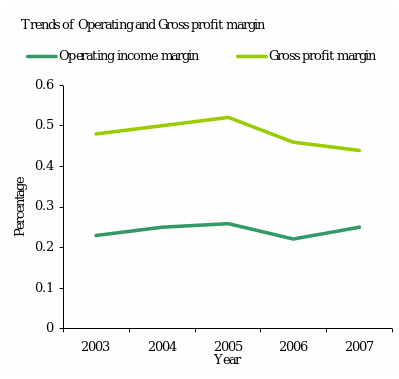
From the above graph, it is seen that spread between operating profit margin and net profit margin is lower indicates HSBC has superior administrative efficiencies. In 2007 operating margin was 24% while gross profit margin was 48%. So, HSBC is enjoying higher income by minimizing cost of indirect expenses effectively. On the other hand the growth rate of dividend payout ratio is declining. The bank may be attempted to increase its retained earnings. Return on equity is also declining means numbers of stakeholder is increasing with constant income as firm may want to raise more funds.
Saudi Hollandi Bank
Table-4:
Net profit margin is quite high in compare with HSBC. Bank’s indirect cost management is good enough. Apart from banks commission services, others revenues segmented in operating income is very much good. Earning per share is quite low for Saudi Hollandi Bank. Overall in terms of profitability Saudi Hollandi Bank is better than HSBC.
Competitive analysis: technology usage/ branching, strategic alliances
Competitive analysis
The competitive behavior is fluctuated from perfectly competitive movement. The market niche is important for competition as where most commercial banks are concentrated. The market niche is lending to small and medium size enterprise and private customers. Here the competitive pressure is moderate. The niche is profitable. As the large banks are facing problems to finance in the industrial area the small sized banks are getting more advantages as large amount of financing are done form direct finance. Form the picture below the scenario can be comprehended.
Table-5:
On the other hand Saudi Arabia banks are facing more advantages in lending in industrial financing. The largest banks are making more profit through financial services and trading securities
Technology usage/branching-domestic and international
In technology using HSBC is in ahead than Saudi Hollandi Bank. It is equipped modern technologies like internet, extranet, intranet, ATM, e-payment system, online banking, cellular banking and etc.
Loan/loss provisions and policies
HSBC and Saudi Hollandi Bank maintain some criteria to accumulate loan loss and provision.
- The future cash flow or operational activities will be affected by the loan loss impairment.
- The asset is acknowledged with the accounting period and balance sheet date
- The amount of loan loss can be estimated
The loan loss allowance is evaluated in following ways:
Individually assessed loan allowance
To recognize the loan loss as individually, all the relationships pf counter party are evaluated. The major conditions are whether there is breach of contract, financially disruption or delinquency in interest rate or principle payments. The loan loss allowance is estimated by the following ways:
Amount of loss=Carrying amount of loans (Including accrued interest) – Estimated recoverable amount
Collectively assessed loss allowance
The collectively loan loss is determined by assessing that the impairment of loan is individually significant but there is no significant evidence. This might be happen due to country risk, transfer and convertibility risk. Therefore, the risks are recognized and a allowance is estimated. Based on historical data on homogeneous group a probable loss and allowance are estimated.
When HSBC finds any impaired loans the previous accrual interest is considered as interest income and a separate provision of loss is shown in the income statement. When it becomes certain that the loan is irrecoverable forever, the loan together with the associated allowance is charged off.
The graph below shows the loan loss provision for Saudi Hollandi Bank the service sector contains more amounts for loan provision.

As HSBC is more diversified the presentation of provision for loan and advances would be best to framed in different regions. North America is in a greater risk as it contains more percentage of provision for impaired loan.
Table-6:
Assets/Liability diversification
Saudi Hollandi Bank
From the figure in asset section due from banks and other financial institutions, Europe contains more. Saudi Arabia operates its major banking operations here and is affiliated with many organizations.
From the figures bellow investment is more in native country though affiliation is in Europe contains high. The bank is not intending enough to diversify its asset in other countries as it is a huge potential.
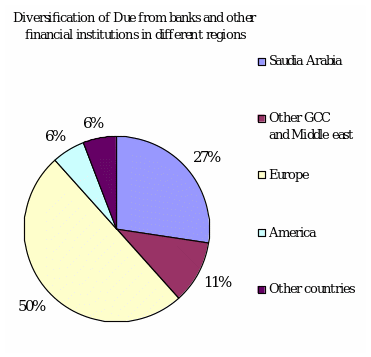
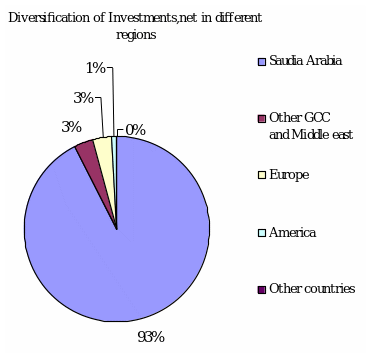
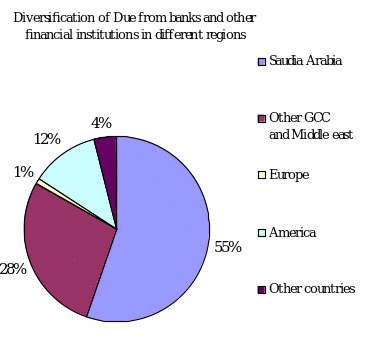
Though investment is high, associated liability is quite high in Saudi Arabia, at least 55%.
From the above diagrams, it is seen that HSBC is diversifying its asset in interest bearing asset and liabilities. As a part of its strategy HSBC is concentrating more in its customer and institutional segments which is contributing its more profit segments in total area.
Derivatives product risk management
The bank manages a range of derivatives for trading and risk management purpose. Derivatives are estimated at fair market value. The sales and trading activities of derivatives products enable customer to take, transfer, modify or reduce the risks. The process of operating derivatives is given below:
- Based on the spread and volumes, traders bids for quote to other participants.
- Managing risk situation is important for setting the limits of carrying risk or the estimation of risk from probable return
- Involve in trading when price or interest rate belongs to an expected level
Derivatives are used by the bank to control risk or to maintain an optimal level of risk. Investor may get advantages or face trouble due to the fluctuation of interest rate/commission rate. So, to avoid future uncertainty the bank hedge specific financial instruments at fixed rate.
The conditions and summary of overall derivatives position of banks are given below:
Table-7:
From above table firm is involved in forward exchange contracts which is attractive towards them for reducing the gap of balance sheet.
In 2007 HSBC has the following condition of derivatives:
HSBC is more concerned with interest rate risk. As HSBC is more diversified, the interest rate in different region affects largely in the interest rate either in positive way or in negative way.
Off balance sheet management
The primary purpose of the off balance sheet items is to make funds available for customers. Some major items, included in the off balance sheet items are:
- Guarantee and standby letter of credits: These are the irrecoverable assurances that the bank will make payment if customer defaults.
- Documentary letter of credit: As same as guarantee and standby letter of credits and are collateralized.
- Commitments to extend credit: indicate the unused portion of authorization to extend credit, mainly in the form of loans and advances, guarantees and letter of credit.
The table shows the amount of off balance sheet item in terms of maturity:
Table-8
Table-9
Form the above table, the bank is carrying more credit risk especially in letter of guarantee segments. At least 55% risks are obtained by this segment. Though the risk is high firm can boost up its return that may not affect the balance sheet.
The guarantees and irrecoverable letters of credits carry the greater portion of risk and increase the rate of return.
These two banks are engaged in off balance sheet management for their project financing, available funds. These items are not shown in the balance sheet, are naturally collaborated by different items. Often Saudi Hollandi Bank believes that the depreciation is charged high and therefore the asset section looks bad, so they engage in off balance sheet management. Some times the project management are facing problem as the terms and condition on borrowing loan are stipulated. So, both of the banks engaged in off balance sheet item to finance their internal operations form external source.
Web Sources
Finance.yahoo.com
finance.google.com
db.com
sama.gov.sa
alfransi.com.sa
hsbc.com
Appendix
Diversification of assets of HSBC
Asset and liabilities of Saudi Hollandi Bank
Key financial indicators of HSBC
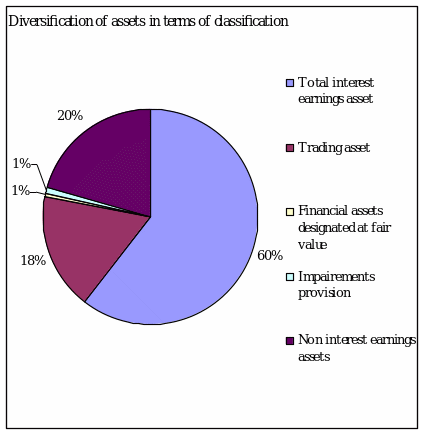

Bibliography
Brigham, E. F., & Houseton, J. F. (2004), Fundamentals Of Financial Management, 10th Edition, Thomson south-western, Singapore, ISBN:0-324-17829-8, pp. 244-294, 350-378.
Ball, L., (1999), Policy Rules for Open Economy, Taylor, J., ed., Monetary Policy Rules, University of Chicago Press, pp.120-145
Clarida, R., J. et al (2000), Monetary policy rules and macroeconomic stability: Evidence and some theory, Quarterly Journal of Economics 115(1), pp. 150–172.
Cottrell, A. (1994), Keynes and the Keynesians on the Fisher effect, Scottish Journal of Political, Economy, 47(4): pp. 430–445.
Encyclopedia Britannica, Inc.(2008), Accounting Encyclopedia, Ultimate Reference Suite. Pp. 560-561.
Enders, W. (2003), Applied Econometrics of Time Series, 2nd ed. Hoboken, New York, Wiley, pp. 78-96.
Hicks, J. R. (1939), Value and Capital.2nd ed. Oxford: Oxford University Press, pp. 212-235.
HSBC Holdings Plc. (2007), Annual Report and Accounts- 2007, London, UK.
Maurice, O. (1997), Open Economy Macroeconomics: Developments in Theory and Policy, Working Paper No. 6319, NBER, pp. 165-174.
McCallum, B. T. & Nelson, E. (1999), Nominal Income Targeting in an Open-Economy Optimizing Model, Journal of Monetary Economics, 43: pp.555-580.
Mishkin, F. S. (2000), The economics of money, Banking and Financial Markets, Financial institutions Journal.34:3.
Pandey, I. M. (2007), Financial Management, 9th Edition, Vikas publishing house PVT LTD, New Delhi, ISBN: 81-259-1658-X pp 38-56, 136, 187, 378-401.
Pierpaolo, B., (2004), Optimal Monetary Policy in a Currency Area, Journal of International Economics 63(2): pp.229-325.
Saudi Hollandi Bank, (2007), AUDITED FINANCIAL STATEMENTS 31 DECEMBER 2006 AND 2005, Jeddah, Saudi Arabia.
Smithin, J. (2003), Controversies in Monetary Economics. Northampton, London: Edward Elgar Wray, pp. 165-217.